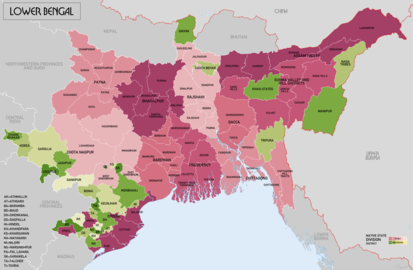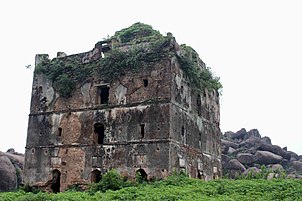Nagvanshis of Chotanagpur
The Nagvanshis of Chotanagpur (also known as the Khokhra chieftaincy), was an Indian dynasty which ruled the Chota Nagpur plateau region (modern-day Jharkhand). Chotanagpur Zamindari was one of many Zamindari estate in the era of the British Raj, in former Bihar Province from 1817 to 1947.[1][2] Lal Chintamani Sharan Nath Shahdeo (1931 - 2014) was last ruling king of the dynasty, until the estate was merged to the Republic of India.[3][4]
Nagavanshis of Chotanagpur Nagvanshi dynasty | |||||||
|---|---|---|---|---|---|---|---|
| 83 CE–1952 CE | |||||||
| Status |
| ||||||
| Capital |
| ||||||
| Common languages | Prakrit, Nagpuri | ||||||
| Religion | Hinduism | ||||||
| Government | Monarchy | ||||||
| Raja (King or Chief) | |||||||
• c.83- c.177 CE | Phani Mukut Rai (first) | ||||||
• 1950–1952 CE | Lal Chintamani Sharan Nath Shahdeo (last) | ||||||
| History | |||||||
• Established | 83 CE | ||||||
• Disestablished | 1952 CE | ||||||
| Area | |||||||
| 1817 | 18,264.6 km2 (7,052.0 sq mi) | ||||||
| |||||||
| Today part of | Jharkhand, India | ||||||
Origin
The origins of the Nagvanshis are shrouded in mystery.[5]
Nagvanshi claim descent from Nagas.[6][7] According to Nagvanshavali, Nagvanshi dynasty originated with Pundrika Naga. According to the story, to avoid killing by Raja Janamejaya the king of Hastinapur, Pundarika Naga assumed the persona of a Brahmin and studied shastras in the house of a Brahmin in Varanasi. Brahmin impressed by intelligence and grace of his pupil got married his daughter Parvati to him. Due to his forked tongue, he always slept with his back to his wife. Wife becomes curious to know about the secret. To avert the question, Naga proposes to do a pilgrimage to Puri. On the way in Jharkhand, wife gave birth to a child. According to custom, secret desire of wife or husband should be fulfilled. Naga compelled to disclosed his identity, assumed the form of Cobra and plunged into the water. Out of grief wife committed Sati. At that time a Brahmin named Janardan while holding sun idol came to see that the Pundarika Naga guarding his child. Pundarika Naga told his story. The Brahmin named the child Fani Mukut Rai. He took the child to the house of Madura Munda the chief of Sutiambe village. Madura adopted and brought the child up with his son of the same age. Madura convened the paraha chief and other Raja, where Fani Mukut Rai became Raja due to his qualities. Phani Mukut Rai was succeeded by his son Mukut Rai. His empire was named ‘Nagpur Des’. According to Nagvanshi tradition, the dynasty was established by Raja Phani Mukut Rai. However, the story of Phani Mukut Rai is mostly considered to be a myth.[8][9]
According to different source, the dynasty was founded in the 5th century AD as a successor state to the Gupta Empire. Phani Mukut Rai was first king.[10][4]
History
According to "Nagvanshavali", Phani Mukut Rai was founder of Nagvanshi dynasty in 1st century. However the story mostly considered to be a myth.[8]
In 12th century, Raja Bhim Karn was ruling from Khukhragarh.[11] There are several ancient palaces, temples, coins and pottery remains found in these places. The remains of the idol of the Sun Temple have been found near Pithoria in Ranchi district and they have been dated to the 12th Century AD.[12][13][14] Sometime between 1098-1113, the Nagvanshis began ruling from Khukhragarh and Mirza Nathan refers to the region as Khokhradesh.[1]. In 1585, There was mughal invasion during reign of Raja Madhu Singh. He became a tributary to the Mughals. Raja Durjan Sal was taken to Prison in Agra for withdrawal of his relationship with Mughals, later he was released for identifying real diamonds. He built palaces, temples and ponds in Navratangarh. Raja Raghunath Shah(1665-1706) was a tributary to the Mughals. During his reign, Raghunath Shah built several temples, including Madan Mohan temple in Boera and Jagannath temple. He was succeeded by his son Yadunath Shah (1706 - 1724).[15]
In 1719, during the reign of Emperor Muhammad Shah, Sarbuland Khan was appointed as the Subedar of Bihar Province. He first settled the Pargana of Sher and Sherghati under Irja Agoury. They proceeded towards the hills. Raja Yadunath Shah, to whom the ghatwal of Palamu, Ramgarh and Badam were subjects, sent Bedman Das Thakur as his agent and agreed to pay Rs. One Lakh as Nazrana. After this Mughal invasion, Yadunath Shah shifted the capital from Navratangarh to Palkot upon realising the weakness of the capital from a defensibility point of view. He was succeeded by his eldest son, Shivnath Shah(1724-1733). Due to non-payment of tribute, Fakhr-ud-daula invaded Khokhra in 1731. He faced considerable resistance from the Raja of Khokhra but both parties reached a compromise. The Subedar received Rs 12,000 from Ghatwal of Ramgarh on the account of Nagvanshi raja and Rs 5000 from Ghatwal of Palamu. When Fakhr-ud-daula was removed from the post of Subedar of Bihar Suba in 1733, the Khokhra chief discontinued payment of tribute to Mughals.[16] Nagvanshi were independent during weak Mughal rule.[17]
After the Battle of Buxar, the East India Company got the right to collect revenue from Bihar, Bengal and Odisha. In 1772, Nagvanshi became a vassal of British rule. Between 1795 to 1800, Maratha invaded Chotanagpur and looted and collected revenue forcefully. The British stationed military forces at Chotanagpur to check the incursions of Marathas. Due to rebellion, refusal of payment of revenue by subordinate Jagirdar and Zamindar under Nagvanshi king, Chotanagpur was brought under direct control by British East India company in 1817 and they reduced Nagvanshi rulers to Zamindars. The Nagvanshi rulers shifted their capital from Palkot to Ratu in 1870.[18]

The last ruler of Nagvanshi dynasty was Lal Chintamani Sharan Nath Shahdeo(1931 – 2014). Zamindari was abolished after independence of India in 1952.[13]
Rulers
Following is the list of Nagvanshi rulers according to "Nagvanshavali" written by Beniram Mehta, and "Baishakh badi" by Drupnath Shahdeo which was given to Governor general of India in 1844.[11]
Raja
- Raja Phani Mukut Rai (c.83- c.177 CE)
- Raja Mukut Rai (c.177- c.232 CE)
- Raja Ghat Rai (c.232- c.273 CE)
- Raja Madan Rai (c.273- c.326)
- Raja Pratap Rai (c.326- c.353)
- Raja Gendu Rai (c.548- c.563)
- Raja Hari Rai (c.563- c.601)
- Raja Gajraj Rai (c.601- c.627)
- Raja Sundar Rai (c.627- c.635)
- Raja Mukund Rai (c.635- c.653)
- Raja Udai Rai (c.653- c.710)
- Raja Kandan Rai (c.710- c.756)
- Raja Jagan Rai (c.756- c.772)
- Raja Bhagan Rai (c.772- c.811)
- Raja Mohan Rai (c.811- c.869)
- Raja Gajghat Rai (c.869- c.905)
- Raja Chandra Rai (c.905- c.932)
- Raja Andunand Rai (c.932- c.969)
- Raja Sripati Rai (c.969- c.997)
- Raja Jogand Rai (c.997-c.1004)
- Raja Nrupendra Rai (c.1004-c.1047)
- Raja Gandharv Rai (c.1047-c.1098)
- Raja Bhim Karn (c.1098-c.1132)
- Raja Josh Jash Karn (c.1132-c.1180)
- Raja Jal-?-Karn (c.1280-c.1218)
- Raja Go Karn (c.1218-c.1236)
- Raja Shivdas Karn (c.1367-c.1389)
- Raja Udai Karn
- Raja Pratap Karn (c.1451-c.1469)
- Raja Chhatra Karn (c.1469-c.1496)
- Raja Virat Karn (c.1497-c.1501)
- Raja Panketu Rai (c.1501-c.1512)
- Raja Baidosal (c.1512-c.1530)
- Raja Madhu Singh
- Raja Bairisal (1599-1614)
- Raja Durjan Sal (1614-1615)(1627-1640)
- Raja Ram Shah (1640-1665)
- Raja Raghunath Shah (1665-1706)
- Raja Yadunath Shah (1706-1724)
- Raja Shivnath Shah (1724-1733)
- Raja Udainath Shah (1733-1740)
- Raja Shyamsundar Nath Shah
- Raja Balram Nath Shah
- Raja Mahinath Shah
- Raja Dhrupnath Shah
- Raja Deo Nath Shah
- Raja Gobind Nath Shah Deo (1806-1822)
Maharaja
- Maharaja Jagannath Shah Deo (1817-1872)
- Maharaja Udai Pratap Nath Shah Deo (1872–1950)
- Maharaja Lal Chintamani Sharan Nath Shahdeo (1950-1952)
Notable people
- Ani Nath Shahdeo, King of Barkagarh
- Vishwanath Shahdeo - Freedom fighter in 1857 rebellion
- Lal Pingley Nath Shahdeo - Jurist and political activist
- Lal Ranvijay Nath Shahdeo - Lawyer, Writer and Political activist
- Lal Vijay Shahdeo, Director
- Gopal Sharan Nath Shahdeo - Prince and Politician
References
- "Archaeologists uncover remains of ancient empire in Jharkhand". oneindia. 11 May 2009.
- "The Nagbanshis And The Cheros". archive.org.
- "Ranchi bids tearful farewell to last Maharaja". dailypioneer. 12 July 2014. Retrieved 14 November 2016.
- "CHOTA-NAGPUR (Zamindari)". members.iinet.net.au. Archived from the original on 5 May 2019. Retrieved 17 March 2019.
- Tahir Hussain Ansari (20 June 2019). Mughal Administration and the Zamindars of Bihar. Taylor & Francis. pp. 163–167. ISBN 978-1-00-065152-2.
- Kumar Tiwari, Shiv (2002). Tribal Roots of Hinduism. Sarup & Sons. p. 264. ISBN 8176252999.
- Paliwal, B. B. (2005). Message of the Purans. Diamond Pocket Books Ltd. p. 21. ISBN 978-8-12881-174-6.
- Asoka Kumar Sen (2017). Indigeneity, Landscape and History: Adivasi Self-fashioning in India. Taylor & Francis. p. 113. ISBN 978-1-351-61186-2.
- "The Lost Kingdom of Navratangarh". IndiaMike.com. 5 February 2015. Retrieved 14 November 2016.
- "History". gumla.nic.com.
- Jharkhand Encyclopedia Hulgulanon Ki Partidhwaniyan-1. books.google.com. Retrieved 9 December 2019.
- "800 years come alive in Pithoria's relics - Archaeological explorations in two hamlets yield artefacts from 12th Century to colonial times". telegraphindia. 8 September 2010.
- "Eye on Nagvanshi remains - Culture department dreams of another Hampi at Gumla heritage site". telegraphindia. 7 May 2009.
- "Ancient capital to open for visitors - Caves & temples at Sutiambe to offer peek into history". telegraphindia. 4 September 2008.
- "Giant new chapter for Nagpuri poetry". telegraphindia. 5 November 2012.
- "Mughal Administration and the Zamindars of Bihar". books.google.com.
- "The Nagbanshis And The Cheros". archive.org.
- "Animal sacrifice alive at Ratu Fort". telegraphindia. 23 September 2009.
